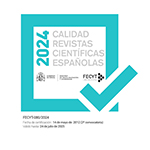Patrimonio y cultura en torno a cultivos singulares: el caso del azafrán en Castilla-La Mancha (España)
Resumen
Los paisajes de la agricultura surgen de la interacción entre la naturaleza y el ser humano a lo largo del tiempo. Más allá de su finalidad productiva, forman parte de la identidad territorial de las personas que los habitan, donde la tradición, el saber hacer y el conocimiento de los ciclos naturales conforman un legado de clara dimensión cultural. El cultivo del azafrán en Castilla-La Mancha (España) genera un paisaje cultural agrario singular, por su modesta dimensión territorial en relación con el importante peso de los recursos patrimoniales, esencialmente de carácter intangible. El resultado de la revisión bibliográfica, en línea con la Carta de Baeza sobre Patrimonio Agrario, el análisis estadístico y el trabajo de campo, constatan la potencialidad del paisaje del azafrán como motor de dinamización económica territorial a través de su valoración como recurso turístico.
Descargas
Descarga artículo
Licencia
La revista Anales de Geografía de la Universidad Complutense, para fomentar el intercambio global del conocimiento, facilita el acceso sin restricciones a sus contenidos desde el momento de su publicación en la presente edición electrónica, y por eso es una revista de acceso abierto. Los originales publicados en esta revista son propiedad de la Universidad Complutense de Madrid y es obligatorio citar su procedencia en cualquier reproducción total o parcial. Todos los contenidos se distribuyen bajo una licencia de uso y distribución Creative Commons Reconocimiento 4.0 (CC BY 4.0). Esta circunstancia ha de hacerse constar expresamente de esta forma cuando sea necesario. Puede consultar la versión informativa y el texto legal de la licencia.












